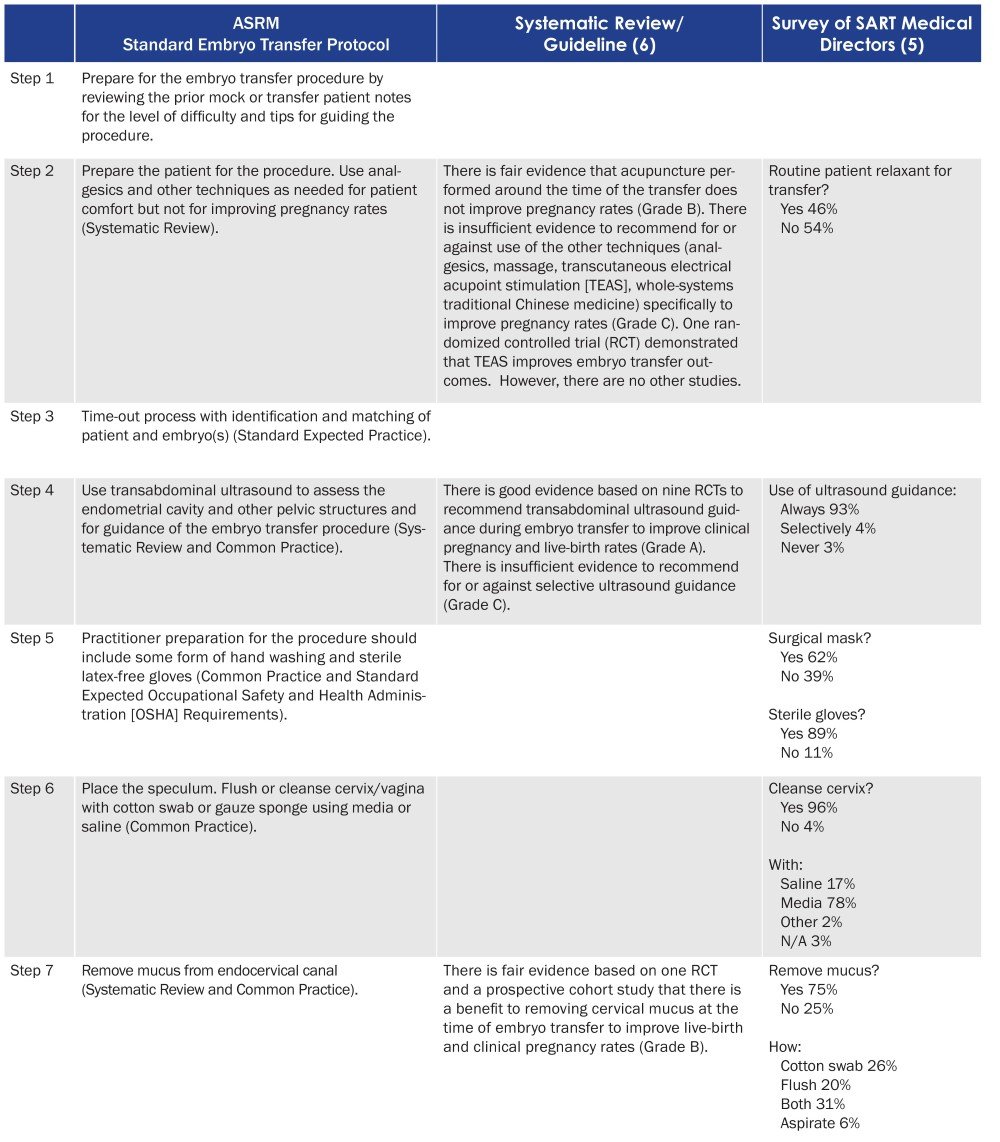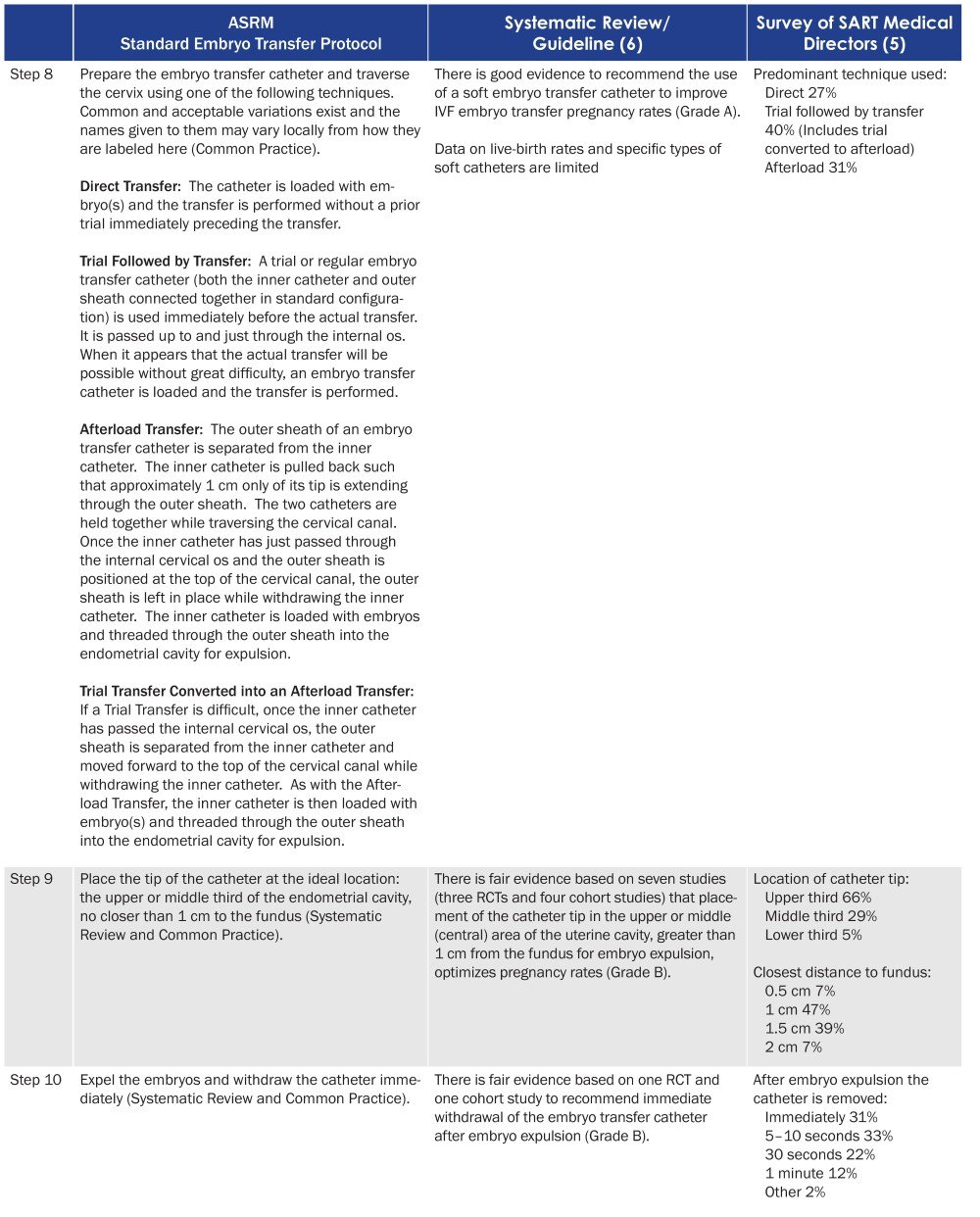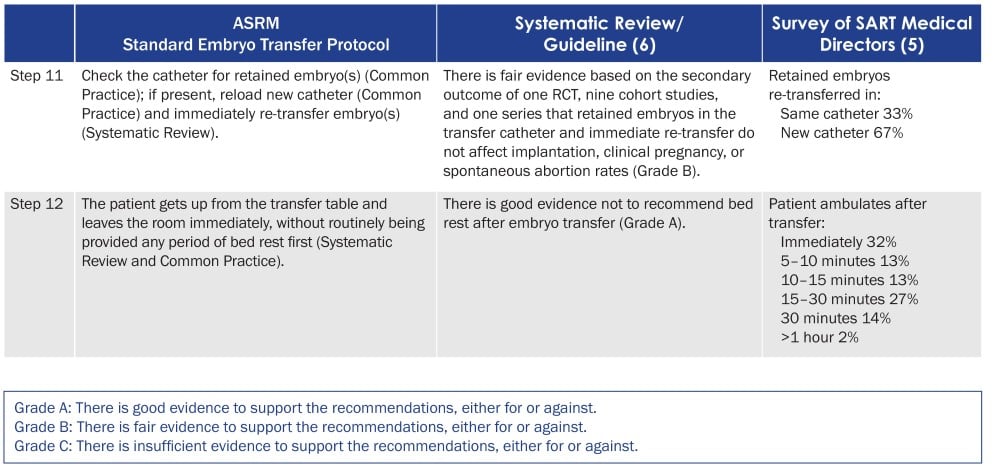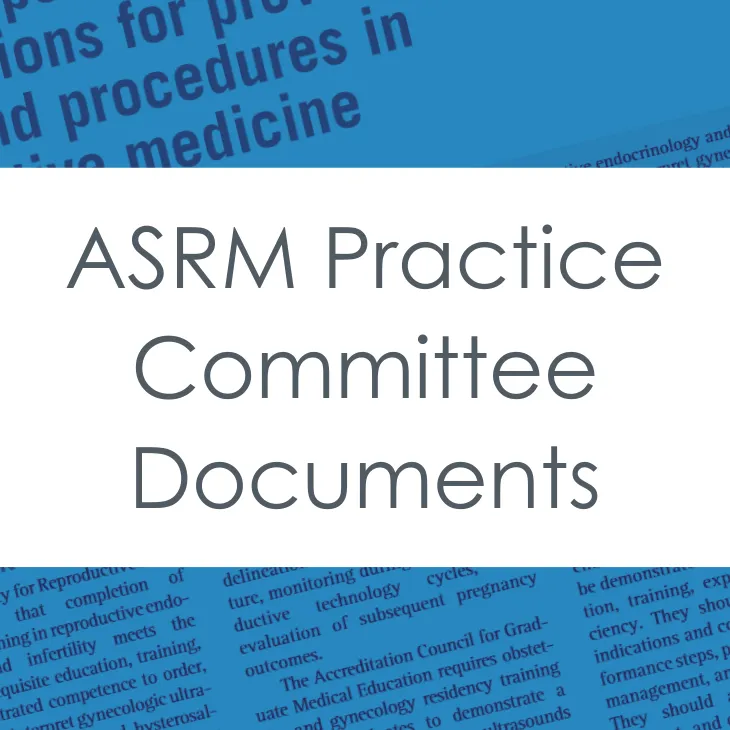ASRM standard embryo transfer protocol template: a committee opinion (2017)
The 2014 to 2019 American Society for Reproductive Medicine (ASRM) Strategic Plan is focused on seven goals. Two of those goals are:1) setting new standards in the continuing medical education of, and, 2) having maximal impact on reproductive medicine. In response to accumulating evidence that suggested a gap in clinician training and standardization of the embryo transfer procedure, ASRM presents the results of an embryo transfer initiative in this issue of Fertility and Sterility. Prior reports have suggested that the majority of fellows in reproductive endocrinology and infertility training perform very few, if any, embryo transfers. In addition, studies have consistently demonstrated that in vitro fertilization (IVF) pregnancy rates vary by the clinician performing the transfer (1–4).
ASRM formed an Embryo Transfer Advisory Panel to move this initiative forward. The panel collaborated with a leading medical simulation company, VirtaMed, to develop a virtual realitybased simulator for training in embryo transfer and intrauterine inseminations. The panel also developed an extensive 82-question survey that was sent to all Society for Assisted Reproductive Technology (SART) medical directors and was completed by 41% of them. The results of that survey are summarized in this issue in the article titled, ‘‘Embryo transfer techniques: an ASRM survey of current SART practices’’ (5). Survey results were used to guide the development of the embryo transfer simulator and to determine common practices around embryo transfer. The results were also used to develop a ‘‘common practice’’ document that allows clinicians to review all of the steps of the embryo transfer procedure and better understand common practice. The survey article can be used to identify variations in clinical practice and potential areas for change.
As part of the embryo transfer initiative, a subset of the Embryo Transfer Advisory Panel served as a special task force of the ASRM Practice Committee to perform a systematic review of the literature around the major steps of the embryo transfer procedure. The goal of this work was to identify those parts of the embryo transfer procedure that are supported by the literature as well as gaps in research for which the literature is unable to provide guidance. A new ASRM guideline, ‘‘Performing the embryo transfer: a guideline,’’ summarizes the findings of that extensive review and is also published in this issue (6).
Figure 1 combines the findings of both the systematic review of the literature and the embryo transfer survey of SART medical directors. In Figure 1 are 12 basic steps of the embryo transfer protocol adopted by the ASRM Practice Committee. A number of the steps are supported by evidence in the literature and the new ASRM guideline on performing the embryo transfer (6). For those steps not supported by the literature, data from the survey demonstrate common practice. While there are acceptable variations around some of the steps included here and the names given to some of the proceduresmay differ locally, the purpose is to fill a need for standardization. Literature on quality and safety is filled with evidence that standardization improves performance and safety (7). The embryo transfer survey paper demonstrates that only 50% of SART practices responding had a standard embryo transfer protocol for all of their clinicians to follow. The ASRM Standard Embryo Transfer Protocol Template provides associated evidence for all practices to use tomodel their ownstandard protocol.
ASRM formed an Embryo Transfer Advisory Panel to move this initiative forward. The panel collaborated with a leading medical simulation company, VirtaMed, to develop a virtual realitybased simulator for training in embryo transfer and intrauterine inseminations. The panel also developed an extensive 82-question survey that was sent to all Society for Assisted Reproductive Technology (SART) medical directors and was completed by 41% of them. The results of that survey are summarized in this issue in the article titled, ‘‘Embryo transfer techniques: an ASRM survey of current SART practices’’ (5). Survey results were used to guide the development of the embryo transfer simulator and to determine common practices around embryo transfer. The results were also used to develop a ‘‘common practice’’ document that allows clinicians to review all of the steps of the embryo transfer procedure and better understand common practice. The survey article can be used to identify variations in clinical practice and potential areas for change.
As part of the embryo transfer initiative, a subset of the Embryo Transfer Advisory Panel served as a special task force of the ASRM Practice Committee to perform a systematic review of the literature around the major steps of the embryo transfer procedure. The goal of this work was to identify those parts of the embryo transfer procedure that are supported by the literature as well as gaps in research for which the literature is unable to provide guidance. A new ASRM guideline, ‘‘Performing the embryo transfer: a guideline,’’ summarizes the findings of that extensive review and is also published in this issue (6).
Figure 1 combines the findings of both the systematic review of the literature and the embryo transfer survey of SART medical directors. In Figure 1 are 12 basic steps of the embryo transfer protocol adopted by the ASRM Practice Committee. A number of the steps are supported by evidence in the literature and the new ASRM guideline on performing the embryo transfer (6). For those steps not supported by the literature, data from the survey demonstrate common practice. While there are acceptable variations around some of the steps included here and the names given to some of the proceduresmay differ locally, the purpose is to fill a need for standardization. Literature on quality and safety is filled with evidence that standardization improves performance and safety (7). The embryo transfer survey paper demonstrates that only 50% of SART practices responding had a standard embryo transfer protocol for all of their clinicians to follow. The ASRM Standard Embryo Transfer Protocol Template provides associated evidence for all practices to use tomodel their ownstandard protocol.
Figure 1

Figure 1 continued

Figure 1 continued

Acknowledgments:
This report was developed under the direction of the Practice Committee of the American Society for Reproductive Medicine as a service to its members and other practicing clinicians. Although this document reflects appropriate management of a problem encountered in the practice of reproductive medicine, it is not intended to be the only approved standard of practice or to dictate an exclusive course of treatment. Other plans of management may be appropriate, taking into account the needs of the individual patient, available resources, and institutional or clinical practice limitations. The Practice Committee and the Board of Directors of the American Society for Reproductive Medicine have approved this report.This document was reviewed by ASRM members and their input was considered in the preparation of the final document. The following members of the ASRM Practice Committee participated in the development of this document. All committee members disclosed commercial and financial relationships with manufacturers or distributors of goods or services used to treat patients. Members of the committee who were found to have conflicts of interest based on the relationships disclosed did not participate in the discussion or development of this document.
Alan Penzias, M.D.; Kristin Bendikson, M.D.; Samantha Butts, M.D., M.S.C.E.; Christos Coutifaris, M.D.; Tommaso Falcone, M.D.; Gregory Fossum, M.D.; Susan Gitlin, Ph.D.; Clarisa Gracia, M.D., M.S.C.E.; Karl Hansen, M.D., Ph.D.; Jennifer Mersereau, M.D.; Randall Odem, M.D.; Robert Rebar, M.D.; Richard Reindollar, M.D.; Mitchell Rosen, M.D.; Jay Sandlow, M.D.; Michael Vernon, Ph.D.
REFERENCES
- Angelini A, Brusco GF, Barnocchi N, El-Danasouri I, Pacchiarotti A, Selman HA. Impact of physician performing embryo transfer on pregnancy rates in an assisted reproductive program. J Assist Reprod Genet 2006;23:329–32.
- Hearns-Stokes RM, Miller BT, Scott L, Creuss D, Chakraborty PK, Segars JH. Pregnancy rates after embryo transfer depend on the provider at embryo transfer. Fertil Steril 2000;74:80–6.
- Karande VC, Morris R, Chapman C, Rinehart J, Gleicher N. Impact of the ‘‘physician factor’’ on pregnancy rates in a large assisted reproductive technology program: do too many cooks spoil the broth? Fertil Steril 1999;71:1001–9.
- Morin SJ, Franasiak JM, Juneau CR, Scott RT. O-63 Live birth rate following embryo transfer is significantly influenced by the physician performing the transfer: data from 2707 euploid blastocyst transfers by 11 physicians. Fertil Steril 2016;106:e25.
- Toth TL, Lee MS, Bendikson KA, Reindollar RH. Embryo transfer techniques: An ASRM Survey of Current SART Practices. Fertil Steril 2017;107:1003–11.
- Practice Committee of the American Society for Reproductive Medicine. Performing the embryo transfer: a guideline. Fertil Steril 2017;107:882–96.
- Leotsakos A, Zheng H, Croteau R, Loeb JM, Sherman H, Hoffman C, et al. Standardization in patient safety: the WHO High 5s project. Int J Qual Health Care 2014;26:109–16.
Practice Documents
ASRM Practice Documents have been developed to assist physicians with clinical decisions regarding the care of their patients.
The use of preimplantation genetic testing for aneuploidy: a committee opinion (2024)
PGT-A use in the U.S. is rising, but its value as a routine IVF screening test is unclear, with mixed results from various studies.
The use of hormonal contraceptives in fertility treatments: a committee opinion (2024)
Hormonal contraception aids in the timing of ART cycles, reduce ovarian cysts at IVF cycle initiation, and optimize visualization before hysteroscopy.
Current evaluation of amenorrhea: a committee opinion (2024)
Amenorrhea is the absence or abnormal cessation of the menses.
Inclusive language and environment to welcome lesbian, gay, bisexual, transgender, queer, questioning, intersex, and asexual+ patients (2024)
Creating an inclusive clinical environment to serve lesbian, gay, bisexual, transgender, queer, questioning, intersex, and asexual+ patients is vital.Topic Resources
View more on the topic of embryo transfer






